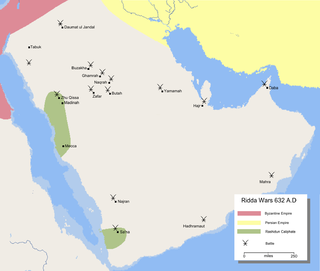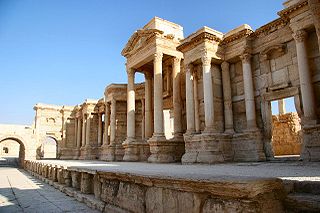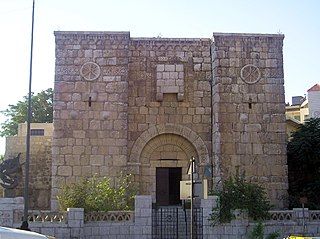
Najd is the central region of Saudi Arabia, in which about a third of the country's modern population resides. It is the home of the House of Saud, from which it pursued unification with Hejaz since the time of the Emirate of Diriyah.
ʿAbd al-Raḥmān ibn Abu Bakr, was an Arab Muslim military commander in the service of the Islamic prophet Muhammad, and the Rashidun caliphs Abu Bakr, and Umar. His mother was Umm Ruman and he was the full brother of Aisha.
Ikrima ibn Abi Jahl was an opponent-turned companion of the Islamic prophet Muhammad and a military commander in the Ridda wars and the Muslim conquest of Syria. In the latter campaign, he was killed fighting the Byzantine forces.

The Ridda Wars were a series of military campaigns launched by the first caliph Abu Bakr against rebellious Arabian tribes. They began shortly after the death of the Islamic prophet Muhammad in 632 and concluded the next year, with all battles won by the Rashidun Caliphate.
ʿĀmir ibn ʿAbd Allāh ibn al-Jarrāḥ, better known as Abū ʿUbayda was a Muslim commander and one of the Companions of the Prophet. He is mostly known for being one of the ten to whom Paradise was promised. He remained commander of a large section of the Rashidun Army during the time of the Rashid Caliph Umar and was on the list of Umar's appointed successors to the Caliphate, but died in the Plague of Amwas in 639 before Umar.
Thābit ibn Qays ibn Shammās al-Ḥārithī al-Khazrajī was a companion of Muhammad, who served as one of his orators and scribes, and a leader of the Ansar, the natives of Medina who gave Muhammad safe haven in their city and were among the earliest converts to Islam.
The Banu Makhzum was one of the wealthy clans of the Quraysh. They are regarded as being among the three most powerful and influential clans in Mecca before the advent of Islam, the other two being the Banu Hashim and the Banu Umayya.
Abū Dujāna Simāk bin Kharasha was a companion of Muhammad and a skilled swordsman who is mentioned in Hadith narrations from the six major Hadith collections of Sunni Islam.
The Battle of Hazir or Ma'arakah al-Haadhir took place between the Byzantine army and the Rashidun army's elite cavalry, the Mobile guard. It took place in June 637, three miles east of Qinnasrin at Al-Hadher in present-day Syria.

The Battle of Walaja was fought in Mesopotamia (Iraq) in May 633 between the Rashidun Caliphate army under Khalid ibn al-Walid and Al-Muthanna ibn Haritha against the Sassanid Empire and its Arab allies. The Sassanid army is said to have been two times the size of the Muslim army during the battle.

The Muslim conquest of the Levant, or Arab conquest of Syria, was a 634–638 CE invasion of Byzantine Syria by the Rashidun Caliphate. A part of the wider Arab-Byzantine Wars, the Levant was brought under Arab Muslim rule and developed into the provincial region of Bilad al-Sham. Clashes between the Arabs and Byzantines on the southern Levantine borders of the Byzantine Empire had occurred during the lifetime of Muhammad, with the Battle of Muʿtah in 629 CE. However, the actual conquest did not begin until 634, two years after Muhammad's death. It was led by the first two Rashidun caliphs who succeeded Muhammad: Abu Bakr and Umar ibn al-Khattab. During this time, Khalid ibn al-Walid was the most important leader of the Rashidun army.

Al-Yamama is a historical region in the southeastern Najd in modern-day Saudi Arabia, or sometimes more specifically, the now-extinct ancient village of Jaww al-Yamamah, near al-Kharj, after which the rest of the region was named.

The Battle of Bosra was fought in 634 CE between the Rashidun Caliphate army and the Byzantine Empire over the possession of the city of Bosra, in Syria. The city was one of the Islamic forces' first significant captures and was at the time the capital of the Ghassanid Kingdom. The siege took place between June and July.

The Rashidun Caliphate was the first caliphate to succeed the Islamic prophet Muhammad. It was ruled by the first four successive caliphs of Muhammad after his death in 632 CE. During its existence, the empire was the most powerful economic, cultural, and military force in West Asia and Northeast Africa.

The siege of Damascus (634) lasted from 21 August to 19 September 634 before the city fell to the Rashidun Caliphate. Damascus was the first major city of the Eastern Roman Empire to fall in the Muslim conquest of Syria.

The Battle of Sallasil, often referred to as the Battle of Chains, was the first battle fought between the Rashidun Caliphate and the Sasanian Persian Empire in April 633. The battle was fought in Kazima by the forces of Khalid ibn al-Walid and the Persians under Hormozd. It was fought soon after the Ridda Wars were over and the Arabian Peninsula was united under the authority of the Caliph Abu Bakr. Indeed, it was the first battle of the Rashidun Caliphate in which the Muslim army elected to extend its frontiers outside of Arabia, thus initiating the Arab conquests.
Abū ʿAbd Allāh Shuraḥbīl ibn Ḥasana was one of the earliest Muslim converts, sahaba and a key commander in the Rashidun army during the Muslim conquest of the Levant.
Khalid ibn al-Walid ibn al-Mughira al-Makhzumi was a 7th-century Arab military commander. He initially headed campaigns against Muhammad on behalf of the Quraysh. He later became a Muslim and spent the remainder of his career in service to Muhammad and the first two Rashidun caliphs: Abu Bakr and Umar. Khalid played the leading command roles in the Ridda Wars against rebel tribes in Arabia in 632–633, the initial campaigns in Sasanian Iraq in 633–634, and the conquest of Byzantine Syria in 634–638.
Al-Qaʿqāʿ ibn ʿAmr ibn Mālik Al-Tamīmī was an Arab Muslim commander and general in the Rashidun army who belonged to the tribe of Banu Tamim. He and his tribe converted to Islam possibly during the time of Ahnaf ibn Qais. He is known as a successful military commander who took part in two important victorious battles in the early Muslim Conquest, the Battle of Yarmouk against the Byzantine Empire and the Battle of al-Qadisiyyah against the Sassanian Empire which was led by Sa`d ibn Abi Waqqas. The Caliph Abu Bakr praised him as an equal to eleven thousand men so in return the caliph's successor, caliph Umar, only sent Qaʿqāʿ and a handful of bodyguards in the first wave of reinforcements to Al-Qadissiyah. Qaʿqāʿ was one of the most illustrious military figures of his era.

The Arab conquest of Mesopotamia was carried out by the Rashidun Caliphate from 633 to 638 AD. The Arab Muslim forces of Caliph Umar first attacked Sasanian territory in 633, when Khalid ibn al-Walid invaded Mesopotamia, which was the political and economic centre of the Sasanian state. From 634 to 636 AD, following the transfer of Khalid to the Byzantine front in the Levant, the hold of Arab forces on the region weakened under the pressure of Sasanian counterattacks. A second major Arab offensive in 636 and ended in January 638 with the capture of Mosul and the consolidation of Arab control over and exclusion of Sasanid influence from the whole Mosul-Tikrit region.










